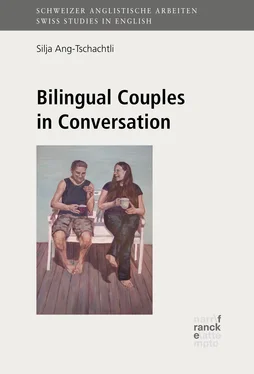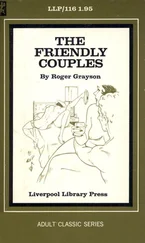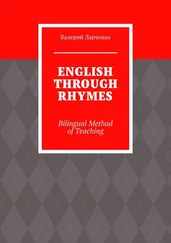On the one hand, linguistic research on bilingual couples has remained relatively scarce, even though studies in the area of individual bilingualism have been plentiful, covering areas as diverse as childhood bilingualism, second language acquisition, and the communication between people from different linguistic backgrounds. This omission is particularly surprising considering how many couples are actually bilingual, and given the diverse and interesting nature of communication among bilingual couples. On the other hand, the studies that do exist on bilingual relationships tend to focus on partners who do not speak the couple language fluently, who speak languages which are not closely related, and/or who are from very different cultural backgrounds (e.g. Rosenblatt and Stewart 2004; Beraud 2016). Only in recent years have couples with similar linguistic and cultural backgrounds shifted into focus, as researchers have begun to look at aspects such as couple identityidentitycouple and language desirelanguage desire (Piller 2002a; Gonçalves 2013). However, there are still many interesting aspects about the communication of bilingual couples that merit research, especially when it comes to partners in established relationships, who are proficient in their couple language.
Since bilingual couples exemplify a wide variety of language combinations and range of individual linguistic situations, they provide fertile ground for research on bilingualism. Depending on the bilinguals’ personal backgrounds, their aptitude for languages, their partner’s language skills and their place of residence, their competence in their partner’s native tongue can range from virtually non-existent to completely proficient. In some cases, both partners are fluent in both languages, while in others, one partner’s mother tongue is the exclusive couple language, or neither of the partners speaks the other’s language, but they speak a third language (lingua francalingua franca) instead. In theory, then, it is not even necessary for both partners in a bilingual relationship to become bilingual. At the same time, there can also be substantial differences in the partners’ level of motivationmotivation to learn each other’s language. Whereas for some, becoming bilingual is an involuntary — but perhaps a necessary — consequence of their relationship, others may have chosen their partner at least in part because of his or her native tongue, which allows them to immerse themselves in another language and to become or stay (fluent) bilinguals.
Furthermore, bilingual couple talk can offer insights into fluent bilingual communication in a manner in which few other types of bilingual interaction do. Many studies on bilingual interaction focus on one-time exchanges involving one or several bilingual speakers who often have limited language skills, rather than conversations between people who are accustomed to each other’s manner of speaking. Unlike the bilinguals investigated in such studies, people in long-term intimate relationshipsrelationshiplong-term are used to interacting with one another; their modes of communication are thus more established than most other forms of bilingual interaction. As a consequence of their repeated interaction, the partners may learn how to read and interpret each other to some degree, and misunderstandings and conflicts may become less frequent over time. If the partners in a bilingual relationship have been together for an extensive period of time and are fluent in the couple language, their communication can be expected to be more advancedadvanced communication than that in most bilingual encounters.1
Finally, another reason why bilingual couples can be a particularly interesting focus for the study of bilingual interaction is that communication tends to take a central role for couples. Communication may be important in any kind of relationship, but especially so in couple relationships, which depend on regular communication to develop and evolve. Thus, some even believe communication to be “the sole major cause of marital happiness or marital failure in modern postindustrial societies” (Piller 2002a: 5). As Crow puts it, “[t]he couple can be viewed, in fact, as the institution in which conversation as a system reaches its fruition: Couples are formed in part to assure oneself a conversational partner with whom to develop a wealth of episodes, and conversation serves as a primary means of developing and enriching a relationship” (1983: 140). Couples will necessarily develop a distinct manner of communicating over time, and adopt aspects of each other’s language use. In the case of bilingual couples, this process of assimilationassimilation might be even more marked than in monolingual couples, as language learning — even at an advanced level — is closely connected to imitationimitation (Brown 1980: 43). Bilingual partners do not just learn aspects of the language itself from one another, but also how to cooperate with one another (for instance in turn-taking and integrating adequate pauses), and to support each other conversationally (for instance with back-channel signals or other-repetition). Fluent speakers in a long-term bilingual relationship therefore fulfil many of the requirements for successful bilingual communication and examining conversations between them should yield substantial insights into how bilingual communication works on a more advanced leveladvanced bilingualism.
In order to explore areas that have not been researched and to give an account of the communication of fluent bilingual couples, I recorded conversations of ten heterosexual bilingual couples, each consisting of a native English speaker and a native Swiss German speaker. In the transcriptionstranscription of their interviews, I included a large variety of suprasegmental features, ranging from terminal pitch to stress and voice quality. The comprehensive corpus resulting from the couples’ conversations and the elaborate transcriptions provided an ideal foundation to closely examine a range of features of their couple language. In order to reduce the number of variables influencing the couples’ communication, I chose couples who share a number of characteristics. For one, all of the couples mainly communicate in English with each other, even though all but one couple, who have a long-distance relationship, reside in Switzerland. While there are considerable differences in the (Swiss) German language skillslanguage skillsproficiency of the English-speaking partners, all of the Swiss partners are highly proficient in English. All of the couples have been together for a considerable period of time, and lived apart from each other in different countries for some of this time. This means that they have had to face and deal with issues that commonly arise in bilingual, bicultural relationships and have become well acquainted with each other’s cultures. The long duration of their relationships increases the likelihood that they have attained a high level of communicative competence in their couple language, and that they have also adopted features from each other’s manner of speaking. It can be expected that all of the couples have developed their own modes of communication, in addition to having a wealth of shared experiences to report, intercultural or otherwise. Consequently, the analysis of these interviews will provide insights into the communication of established bilingual couples, whilst simultaneously filling some gaps in the field of fluent sequentialsequential bilingualism bilingualism.
1.2 Aim and research questions
The main aim of this book is to paint a comprehensive picture of the communication in a bilingual, bicultural relationship between proficient, culturally aware bilinguals. In this context, a number of questions present themselves. Which language(s) do the couples choose to communicate in, and what are the reasons behind this choice? To what extent do they mix languages, and what influences their mixing behaviour? What are the partners’ attitudes towards their bilingual, bicultural relationship? How do partners in a bilingual relationship express positive and negative emotions? How do fluent bilinguals swear, and what affective attachment do expletives in both of their languages have for them? What role do humour and laughter play in their conversations, and what do the couples laugh about? And, finally, do their different mother tongues and their gender have an effect on a variety of areas of their communication?
Читать дальше












